
Republic, 13 chapters, 1948. Starring Clayton Moore, Steve Darrell, Noel Neill, George J. Lewis, John Crawford, Sam Flint.
Jesse James (Clayton Moore) and his brother Frank (Steve Darrell)–who have abandoned their outlaw careers, but are still fugitives from justice–hatch a plan to square themselves with the law, with the aid of old family friend Jim Powell (Stanley Andrews). Frank and Jesse will help veteran prospector Powell develop what promises to be a rich silver mine, and then use their cut of the proceeds to pay back the victims of the James Gang’s robberies. Another old family friend, banker Paul Thatcher (Sam Flint), agrees to bankroll the venture, and hires a mining engineer named Amos Ramsey (John Crawford) to oversee it. Unfortunately for all concerned, Ramsey proves to be an opportunistic scoundrel, and murders Powell under cover of a mine explosion just after the old man has struck gold instead of the expected silver. Ramsey then conceals the unearthed gold vein and does his best to convince Powell’s daughter Judy (Noel Neill) that the property is worthless, hoping to buy the mine for a pittance. Judy, however, decides to keep the mine going–and is backed by Frank and Jesse, who pose as her “cousins,” John Howard and Bob Carroll. Ramsey lends them pretended aid, but secretly enlists a gang of outlaws led by Rafe Henley (George J. Lewis) to help him hamper the mining project; this hampering proves difficult for the villains, however–since it requires them to constantly battle the formidable James Brothers.
Adventures of Frank and Jesse James is an entertaining and well-produced serial, but is nowhere near as memorable as Republic’s first Jesse James chapterplay (Jesse James Rides Again)–being not only far more reliant on stock footage than its predecessor, but also much more routinely plotted; although Adventures’ three screenwriters (Franklin Adreon, Sol Shor, and Basil Dickey) had all worked on Rides Again, their writing here eliminates most of the elements that made the earlier serial distinctive. In Rides Again, Jesse was an outlawed gunfighter with a dark past that was only occasionally alluded to; he came off as a loner and an outsider–and remained one at the end of the serial, after using his deadly skills to save a farming community he himself had no stake in. In Adventures, however, Jesse becomes much more of a conventional serial hero–with the entire narrative focusing on his and Frank’s scheme for erasing their bad records and rejoining lawful society. Said records are also whitewashed far more than Jesse’s past was in Rides Again; the dialogue continually (and needlessly) emphasizes that virtually all of the crimes attributed to the James brothers were actually committed by pretenders making use of the notorious James name (the writers, of course, fail to explain how that name became so notorious in the first place).

Above: Steve Darrell (center) and Clayton Moore prepare to sign the mining agreement drawn up by the seated Sam Flint.
Adventures’ writers do make interesting use of the James brothers’ outlaw status on occasion; the dilemma that arises from it in Chapter Nine gives a novel (if short-lived) twist to the chapterplay. Ramsey’s eventual discovery of the brothers’ identities–and his attempt to use the information against the heroes in the final chapter–is also a good idea, but should have been introduced much earlier; it would have lent some much-needed suspense to the serial. Adventures lacks the looming deadline that plagued the protagonists of other Republic Western serials, and as a result the villains’ often successful attacks on the Powell mine seem more like temporary obstacles than potentially ruinous setbacks; had the heroes been placed in imminent danger of exposure at the serial’s midway point, it would injected more urgency into their uphill struggle to strike gold. As it is, this lack of suspense makes the continual encounters between Rafe’s gang and the James brothers–as the former try to steal ore samples, blow up tunnels, and destroy mining equipment, and the latter try to prevent or repair the ensuing damage–more noticeably repetitious.
Repetitive though the serial’s action is, the action scenes themselves are quite exciting, being well-directed by Fred Brannon and Yakima Canutt and well-performed by the Republic stunt team. Tom Steele doubles Clayton Moore in the fight scenes–save in one sequence during which Dave Sharpe takes over the “starring” role; Sharpe also doubles for Steve Darrell, while Dale Van Sickel stands in for George J. Lewis. Fred Graham, Duke Taylor, Joe Yrigoyen, Eddie Parker, Ken Terrell, Carey Loftin, Bud Wolfe, Duke Green, and Guy Teague are all on hand as well. The fistfight scenes are uniformly excellent, but a few of the standouts are the well-shot Chapter One bank brawl, the barn fights in Chapters Four and Ten, the destructive cabin battle in Chapter Seven, and the fights at the mine in Chapters Eight and Twelve. All of these sequences (and many others) feature staging and camerawork that’s a good deal more dynamic-looking than Republic’s post-war norm–probably because of the directorial input of master stuntman Canutt.
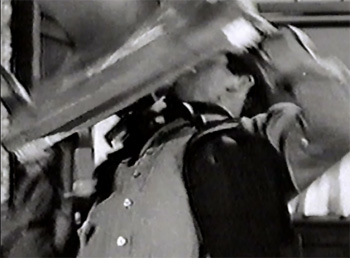
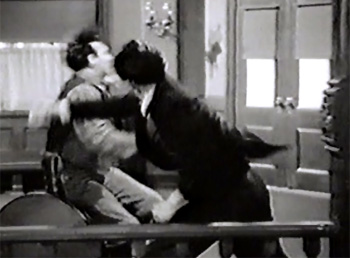
Above: Fred Graham takes a chair to the face (left); Tom Steele slugs Dale Van Sickel (right). Both shots are from the Chapter One bank fight.
The chase in the hills in Chapter Six and the cliff-top battle that follows it is yet another standout; like other outdoor scenes in the serial, it makes good use of the hills of Iverson’s Ranch. Adventures’ shootouts–both in the hills and on Republic’s western-town street–are strong as well, particularly the clash between Jesse and Rafe on the street in Chapter Four, the nighttime assault on the doctor’s office in Chapter Ten, and the strikingly-shot gunfight inside the bank in Chapter Thirteen. Adventures’ shootout scenes also provide a welcome echo of the first Jesse James serial; like Jesse in that outing, the James brothers here manage to fatally perforate an unusually high percentage of heavies during gun battles, helping them to maintain at least some of the dangerousness proper to legendary outlaws.

Above: Clayton Moore fires down the street towards a just-out-of-sight George J. Lewis.
Other action scenes–among them the rescue of the stage in Chapter Three, the stagecoach race in Chapter Five, the buckboard chase in Chapter Nine, and the fight by the water tower in Chapter Twelve–draw extensively on stock footage from Adventures of Red Ryder, often following entire sequences from the earlier serial almost scene for scene. Although the borrowed shots are inserted seamlessly, their frequent use has one occasionally distracting side effect: Clayton Moore’s Jesse is forced to wear Red Ryder star Don Barry’s broad-brimmed hat and cowboy chaps for almost the entire serial–which, though appropriate to a rancher hero like Barry’s Ryder, looks more than a little incongruous on a character who’s supposed to be overseeing a mine. Steve Darrell’s Frank also looks rather silly at times in the buckskins worn by Hal Taliaferro’s sidekick character in Ryder.

Above: Clayton Moore gallops across Iverson’s in full Red Ryder regalia.
Oddly enough, though Red Ryder footage is quite noticeable during in-chapter action, it only figures in three of the cliffhanger scenes (the stagecoach flying off the bridge, the hero being trampled by horses, and the villain lassoing the hero from the seat of a stagecoach). Most of the other chapter endings are made up of original footage, and while several of the new perils are fairly mundane (Frank, Jesse, and Judy each figure in their own “apparent shooting” cliffhanger), others are quite good–particularly the blazing powder that traps Frank in Chapter Three, the wicked-looking harrow that topples down onto Jesse in Chapter Four, and the scythe that impales Jesse in close-up (or so it seems) in Chapter Ten. Less violent, but equally good, is the ending to the wittily-titled ninth chapter (“The Eyes of the Law”), which has the Marshal searching for his spectacles as he prepares to examine a document that will expose the James brothers.
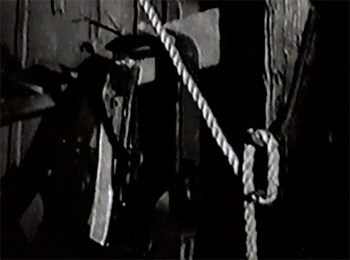

Above: The rope holding the harrow (left) begins to slip and drop the lethal implement (right) towards our hero.
Although his character is somewhat softened this time around (as mentioned above), Clayton Moore does a very good job in his second turn as the reformed Jesse James. He’s earnestly regretful whenever the blot on his name is mentioned, and quietly cheerful when laying plans to remove the blot; he also retains something of the menace he displayed in the first Jesse James serial, favoring the villains with icy and near-murderous glares in various confrontations–particularly his run-in with the crooked land clerk in Chapter Nine.
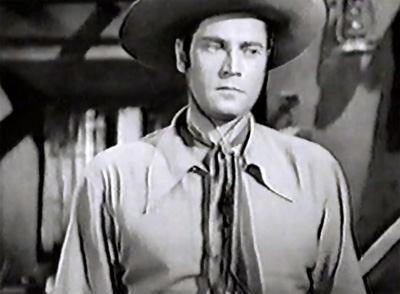
Above: Clayton Moore questions an off-camera captive outlaw.
Steve Darrell is capable but fairly bland as Frank James–although he does show sparks of a tough and wily screen personality in the few scenes that allow him to take the spotlight (such as his rescue of a captured Jesse in Chapter Seven). For the most part, however, he’s relegated to serving as Moore’s backup in action scenes, and fails to make much of an impression. Noel Neill is perkily charming as Judy Powell–reacting with feisty indignation to the villains’ actions or to aspersions on the James boys’ name, and cheerfully enthusing about the hoped-for success of the mine (sometimes to an almost bubbly extent).


Above: Steve Darrell and Noel Neill.
As the villainous Amos Ramsey, John Crawford is convincingly pleasant and unassuming when he’s posing as a hard-working mining engineer in the good guys’ presence–and is also effectively cool and shrewd when laying villainous schemes, doing a particularly good job with his calculating facial expressions just before his murder of Jim Powell. George J. Lewis brings an air of cynicism and cold-bloodedly practical ruthlesness to his turn as Rafe Henley, sneering and snarling to fine effect as he goes about his henchman duties. However, he and Crawford don’t contrast as livelily as the members of an ideal brains-heavy/action-heavy ought to–being a little too similar in their underplayed acting styles; pairing a more boisterous actor like Roy Barcroft with Crawford (or teaming Lewis with someone like I. Stanford Jolley) would have lent more energy to the villains’ plotting scenes.
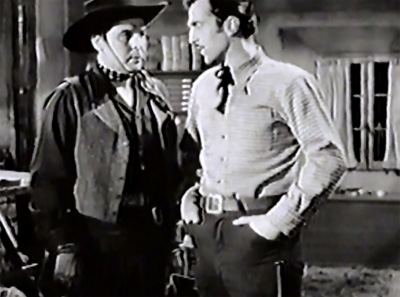
Above: George J. Lewis (left) and John Crawford.
Sam Flint is a welcome presence as the benevolent banker Paul Thatcher, steadfastly and dignifiedly supporting Frank and Jesse, but periodically betraying an understandable nervousness over the potential consequences of his alliance with the outlaws; the combination of suaveness and genteel panic with which he reacts to the risky legal hearing in Chapters Nine and Ten is particularly enjoyable. Stanley Andrews, though prominently billed in the opening credits, only receives about ten minutes of screen time before being killed off, but does get to express an endearing jubilation over his gold strike–as well as display a touching eagerness to make amends to his daughter for the “lean years” caused by his previously unsuccessful prospecting; his likable characterization makes his ensuing murder a little more poignant than the parental demises in many other serials.
In an amusing piece of in-joking, Tom Steele and Dale Van Sickel make appearances as villains actually named Steele and Dale; Fred Graham has a nice bit as a swaggering bank robber who poses as Jesse James himself, while Dave Sharpe, Eddie Parker, and the serial’s other stuntmen all play at least one henchman role. Lane Bradford, in his first Republic serial, also makes appearances as two separate outlaws. House Peters Jr. appears in several chapters as the town sheriff, while Steve Clark has a small role as a sheriff in a neighboring town and Gene Roth is a cranky and near-sighted marshal. Rosa Turich is amusing as the heroine’s bustling and sympathetic maid, while George Chesebro is also enjoyable in his periodical appearances as a genial express agent. Bud Osborne is a villainous stage driver and Jack Kirk a non-villainous one; I. Stanford Jolley pops up as a slick lawyer, Frank O’Connor as a doctor, and James Dale as the aforementioned crooked land clerk.
Adventures of Frank and Jesse James is, overall, one of Republic’s more forgettable late-1940s serials, due largely to its pedestrian storyline. However, it still makes for entertaining viewing–thanks to its strong leading man, its good supporting cast, its above-average action scenes, and Republic’s typically fast pacing and slick production values.
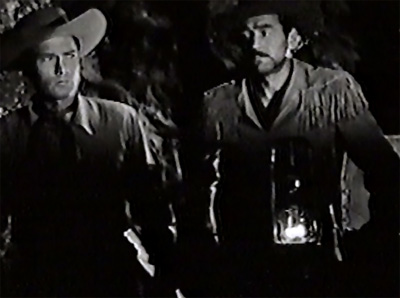
Not bad, not good just so so effort from Republic.
Rating………..## out of #####
I believe this was the first Republic serial to dress the hero to match outfits from an earlier serial. Like you said above, some sequences match scene for scene from RED RYDER. Chapter two goes beyond that, where it matches RED RYDER chapter two totally. Only thing it was missing was a henchman with an eye patch.
this is the point at which Republic’s western serials became very predictable and clichéd. ** out of *****
I can only add that Clayton Moore does NOT stomp around in a big floppy hat and flapping chaps except when he is made to. Fortunately he to wear a better-tailored outfit in a couple of episodes. Unlike most serial outlaws, George J. Lewis had several different outfits … any idea who they were matching him to?
Personally, I think the serial could have benefited from Jack Ingram-style head-henchman sarcasm as each of the bad guys’ plans to get the mine fails and grumbling when he has to ride out and trade lead with the brothers yet again. He also could have been the gang’s “representative (or instigator)” in asking for additional money based on how many gang members never came back from their “jobs”. I’m visualizing a scowling John Crawford grudgingly handing over money while looking daggers at him.
Generally lackluster followup to the first outing. As with so many sequels, it’s entertaining but just doesn’t capture the interest in the same way as the original. Clayton Moore is excellent as always, but the remainder of the cast and the narrative are pretty much by the numbers.